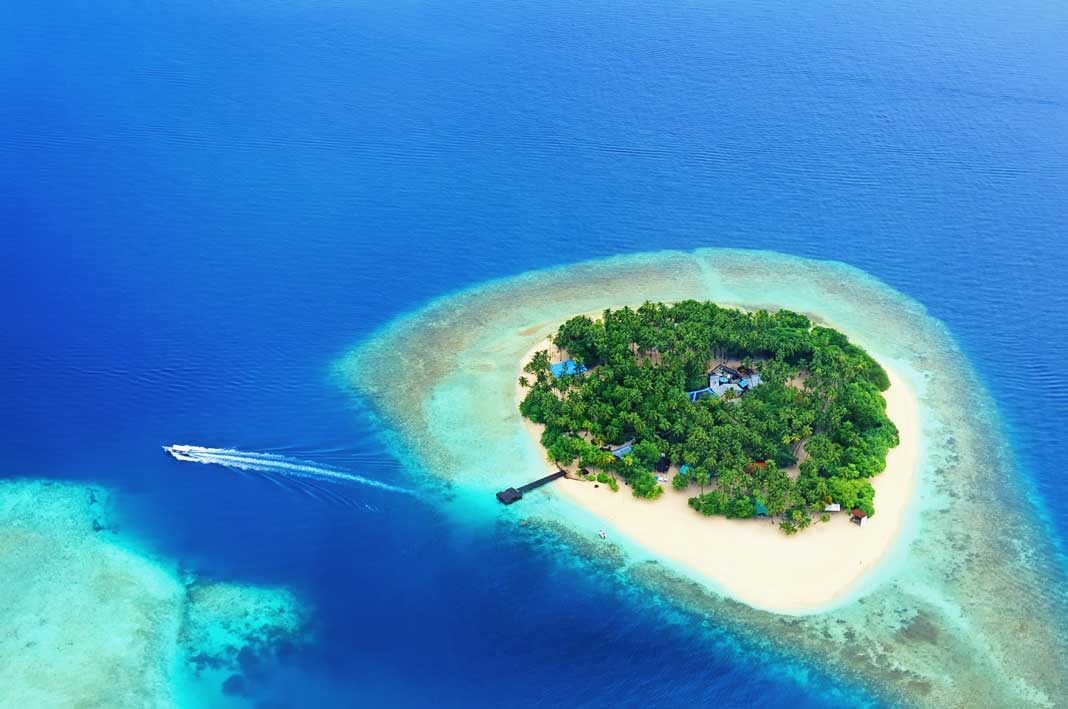Let’s set sail on an adventure to the tiniest island in the world! Islands are like little worlds, with their own ecosystems, history, and people. Bishop Rock, a tiny island off the coast of England, was once recognized as the smallest island in the world by Guinness World Records. However, after its lighthouse was automated, the record for the smallest island shifted to Just Room Enough Island. Together, we’ll dive into what makes an island the smallest, where to find these geographical marvels like Bishop Rock and Just Room Enough Island, and why these tiny lands are so important. We’ll also explore the challenges these islands face and the unique experiences they offer.
Smallest Island: A Look at the World’s Tiniest Patches of Land
Ever wondered about the smallest island in the world? It’s a question that sparks curiosity about the extremes of our planet. While the answer might seem simple, it’s actually a bit tricky and depends on what we even consider an “island.”
There are a few factors that contribute to the determination:
- Size: This is the most obvious factor, with the smallest islands being able to accommodate only a few structures or a limited number of trees.
- Permanent Structures: The presence or absence of permanent structures, such as lighthouses or research stations, can play a role in the classification.
- Geological Formation: The geological processes behind the island’s formation, such as volcanic activity, coral reef development, or sediment accumulation, can influence its size and characteristics.
Bishop Rock: A Lighthouse on a Rock
Off the rugged coast of Cornwall, England, perches Bishop Rock – a minuscule island that is, for all intents and purposes, a large rock jutting out from the sea. To put its size into perspective, it’s roughly the length of a bowling lane and only as wide as a couple of cars parked side-by-side. But don’t let its diminutive stature fool you; this rocky outcrop was once officially declared the smallest island in the world by Guinness World Records.
What makes Bishop Rock truly remarkable is its iconic lighthouse. Erected in 1858, the lighthouse stands as a testament to human ingenuity and resilience against the unforgiving forces of nature. Towering over 160 feet tall, this “King of Lighthouses” has served as a beacon of hope for seafarers navigating the treacherous waters around the Isles of Scilly for well over a century.
Just Room Enough Island: A House, a Tree, and Not Much Else
Across the Atlantic, nestled amidst the picturesque Thousand Islands in New York State, lies a curious patch of land aptly named Just Room Enough Island. This speck of an island, measuring a mere 3,300 square feet (smaller than the average backyard!), earns its name by barely accommodating a solitary house and a handful of trees.
What truly captures the imagination is that Just Room Enough Island is inhabited. It begs the question, what is it like to co-exist with your family and nature in such a confined space? Its existence throws a rather large wrench into the ongoing debate of what truly defines the smallest inhabited island.
Simping Island: A Tiny Paradise Undisturbed
Venturing into the realm of uninhabited islands, we encounter Simping Island. Officially recognized by the United Nations as the smallest uninhabited island, Simping Island, measuring a mere 1.23 acres, stands as a testament to the fact that size is no barrier to biodiversity. It serves as a poignant reminder of the importance of conservation efforts to protect these fragile ecosystems.
So, Who Wins?
Ultimately, the question of which island reigns supreme as the smallest hinges on how we choose to define “smallest.” While Bishop Rock may hold the official record (at least for now!), Just Room Enough Island presents a compelling counter-argument.
Some proponents believe that an inhabited island, by its very nature, holds a greater claim to the title, making Just Room Enough Island the victor. Conversely, others maintain that size should be the sole determining factor, irrespective of habitation.
The lack of a definitive answer is part of what makes this topic so captivating. It challenges our preconceived notions of what constitutes an island and underscores the remarkable diversity found in even the most unexpected corners of our planet.
Where is the Smallest Island in the World Located?
The majority of the smallest island nations are scattered across the globe like hidden gems, each with its own unique charm and appeal.
- Caribbean Sea: Known for its crystal-clear water and vibrant marine life, the Caribbean Sea is home to a number of these tiny island nations.
- Pacific Ocean: The Pacific Ocean, the largest ocean on Earth, is dotted with these miniature marvels, each offering a glimpse into the incredible biodiversity of the region.
- Mediterranean Sea: Rich in history and culture, the Mediterranean Sea also harbors some of these tiny islands, some of which have played significant roles in ancient trade routes and civilizations.
- South China Sea, Atlantic Ocean, and Indian Ocean: Other minuscule islands are tucked away in the South China Sea, the Atlantic Ocean, and the Indian Ocean. Each region boasts its own distinctive characteristics, making each island unique.
The History and Significance of Tiny Islands
These islands, seemingly insignificant in the vast expanse of the ocean, hold a captivating allure that extends far beyond their diminutive size. They are like time capsules, preserving glimpses into the past and offering insights into the intricate workings of nature.
One of the most fascinating aspects of tiny islands is their role as biodiversity hotspots. Isolated from larger landmasses, these islands have become natural laboratories of evolution. The unique environmental pressures have led to the development of species found nowhere else on Earth. From rare plants adapted to harsh coastal conditions to birds with distinct plumage, each species tells a story of survival and adaptation.
Beyond their ecological importance, tiny islands also offer a window into human history and culture. For centuries, people have navigated the challenging waters, settling on these isolated pieces of land and forging unique ways of life. Island cultures are often characterized by a deep connection to the sea, a strong sense of community, and a rich tapestry of traditions passed down through generations. These cultural nuances, often shaped by isolation, serve as a reminder of the resilience and adaptability of the human spirit.
However, despite their ecological and cultural significance, tiny islands face an uncertain future. Climate change poses one of the most substantial threats to their existence, with rising sea levels threatening to submerge these low-lying landmasses. Limited resources, coupled with the challenges of waste management and freshwater scarcity, add further layers of complexity to their survival.
Recognizing the ecological and cultural treasures these islands hold, there is a growing movement to protect and preserve them. Conservation efforts are underway globally, focusing on sustainable practices, habitat restoration, and raising awareness about the unique vulnerabilities these islands face. International cooperation and local community involvement are paramount in ensuring the continued existence of these fragile ecosystems.
Embark on Your Own Tiny Island Adventure
Imagine setting foot on one of these miniature marvels. The experience is both humbling and awe-inspiring. You can witness the architectural wonder of the Bishop Rock Lighthouse, standing tall against the elements. Or perhaps you’ll be captivated by the simplicity and charm of Just Room Enough Island, where life is lived on a miniature scale.
For those seeking a travel experience that goes beyond the ordinary, a trip to a tiny island offers a unique opportunity to connect with nature, immerse oneself in local cultures, and gain a newfound appreciation for the delicate balance of life on Earth. Escape to a world of tranquility on the smallest populated island in the world, where pristine beaches meet crystal-clear waters, inviting you to lose yourself in blissful solitude. Dive into the enchanting allure of the smallest inhabited island in the world, where nature’s touch and the gentle caress of the ocean create a paradise untouched by time. Discover the secluded beauty of small tropical islands, where lush greenery intertwines with vibrant coral reefs, beckoning you to explore their unspoiled wonders.
From the towering lighthouse of Bishop Rock to the cozy confines of Just Room Enough Island, the world’s tiniest islands offer a glimpse into the extraordinary diversity of our planet. They remind us that size is no measure of significance and that even the smallest corners of the Earth can hold immense beauty, ecological importance, and a rich tapestry of human history. So, the next time you gaze upon a map, take a moment to appreciate those tiny dots sprinkled across the vast expanse of blue – they might just surprise you.













Comments are closed.